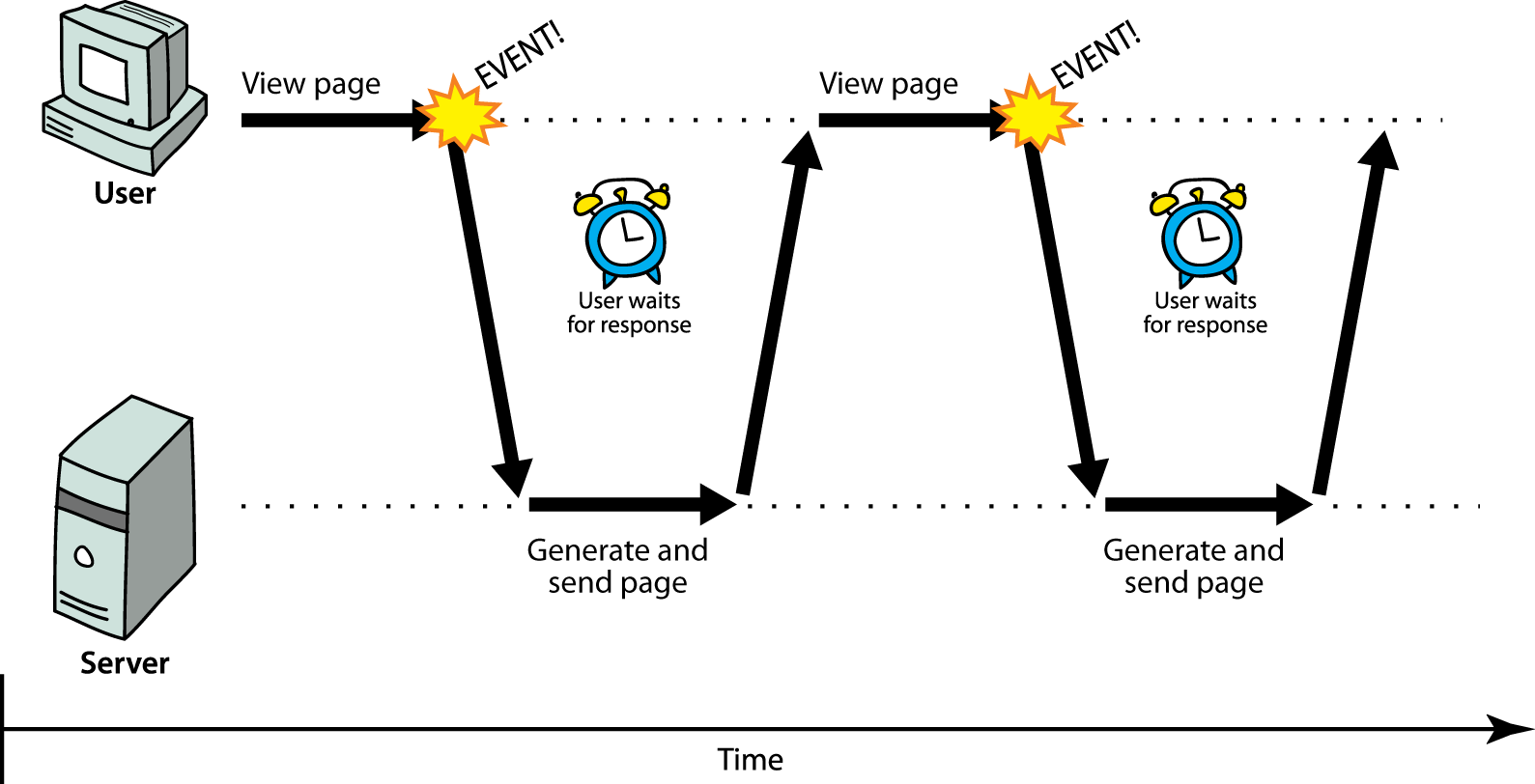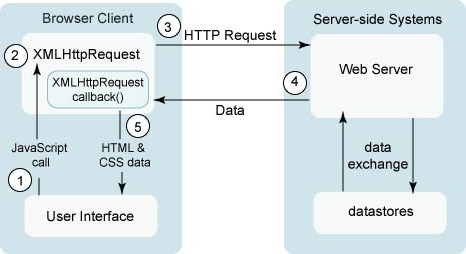CSE 190M Web Programming
Lecture 18: Ajax
Reading: 12.1 - 12.2
Except where otherwise noted, the contents of this document are Copyright 2012 Marty Stepp, Jessica Miller, Victoria Kirst and Roy McElmurry IV. All rights reserved. Any redistribution, reproduction, transmission, or storage of part or all of the contents in any form is prohibited without the author's expressed written permission.
Synchronous web communication

- synchronous: user must wait while new pages load
- the typical communication pattern used in web pages (click, wait, refresh)
Web applications and Ajax

-
web application: a dynamic web site that mimics the feel of a desktop app
- presents a continuous user experience rather than disjoint pages
- examples: Gmail, Google Maps, Google Docs and Spreadsheets, Flickr, A9
-
Ajax: Asynchronous JavaScript and XML
- not a programming language; a particular way of using JavaScript
- downloads data from a server in the background
- allows dynamically updating a page without making the user wait
- avoids the "click-wait-refresh" pattern
- examples: UW's CSE 14x Diff Tool, Practice-It; Google Suggest
Asynchronous web communication

- asynchronous: user can keep interacting with page while data loads
- communication pattern made possible by Ajax
XMLHttpRequest (and why we won't use it)
- JavaScript includes an
XMLHttpRequestobject that can fetch files from a web server- supported in IE5+, Safari, Firefox, Opera, Chrome, etc. (with minor compatibilities)
- it can do this asynchronously (in the background, transparent to user)
- the contents of the fetched file can be put into current web page using the DOM
- sounds great!...
- ... but it is clunky to use, and has various browser incompatibilities
- jQuery provides a better wrapper for Ajax, so we will use that instead
A typical Ajax request

- user clicks, invoking an event handler
- handler's code creates an
XMLHttpRequestobject XMLHttpRequestobject requests page from server- server retrieves appropriate data, sends it back
XMLHttpRequestfires an event when data arrives- this is often called a callback
- you can attach a handler function to this event
- your callback event handler processes the data and displays it
An aside: Creating a new anonymous object
var name = {
fieldName: value,
...
fieldName: value
};
var pt = {
x: 4,
y: 3,
distanceFromOrigin: function() {
return Math.sqrt(this.x * this.x + this.y * this.y);
}
};
alert(pt.x + ", " + pt.y + ", dist=" + pt.distanceFromOrigin());
- in JavaScript, you can create a new object without creating a class
- the object can have methods (function properties) that refer to itself as
this
jQuery's ajax method
$.ajax({
"url": "http://foo.com",
"option" : "value",
"option" : "value",
...
"option" : "value"
});
- call the
$.ajax()method - constructor accepts an object literal full of options that dictate the behavior of the AJAX request:
- the
urlto fetch, as a String, - the
typeof the request, GET or POST - etc...
- the
- hides icky details of the raw
XMLHttpRequest; works well in all browsers
$.ajax() options
| option | description |
|---|---|
url |
The URL to make a request from |
type |
whether to use POST or GET |
data |
an object literal filled with query parameters and their values |
dataType |
The type of data you are expecting to recieve, one of: "text", "html", "json", "xml" |
timeout |
an amount of time in seconds to wait for the server before giving up |
success |
event: called when the request finishes successfully |
error |
event: called when the request fails |
complete |
event: called when the request finishes successfully or erroneously |
jQuery AJAX example
$.ajax({
"url": "foo/bar/mydata.txt",
"type": "GET",
"success": myAjaxSuccessFunction,
"error": ajaxFailure
});
function myAjaxSuccessFunction(data) {
// do something with the data
}
function ajaxFailure(xhr, status, exception) {
console.log(xhr, status, exception);
}
- attach an event handler function to the request's
successanderrorevents
Exercise: output comparison tool
This example uses this output page
- Add AJAX code to load in a hw output file into the
textarea
AJAX data parameter
The data passed to your success handler will be in whatever format you specified in the dataType option
- a
dataTypeof text returns raw text no matter its apparent data type - a
dataTypeof html returns raw html text - a
dataTypeof xml returns an XML document object - a
dataTypeof json returns a JSON object
Handling Ajax errors
$.ajax(
"url": "http://foo.com",
"type": "GET",
"success": functionName,
"error": ajaxFailure
});
...
function ajaxFailure(xhr, status, exception) {
console.log(xhr, status, exception);
}
- for user's (and developer's) benefit, show an error message if a request fails
Exercise: AJAX error
- Add an item to the drop-down that does not exist on the server
- Make sure our code fails noticeably when the AJAX call fails
Better jQuery AJAX
Rather than specify all of the options in an object literal...
$.ajax({
"url": "http://foo.com",
"type": "GET",
"success": functionName,
"error": ajaxFailure
});
one can pass the URL as the first parameter and the rest as an object literal.
$.ajax("http://foo.com", {
"type": "GET",
"success": functionName,
"error": ajaxFailure
});
Why? It makes it even easier to see what this AJAX request is doing.
Even Better jQuery AJAX
Rather than supply the handlers as fields in the options object...
$.ajax("http://foo.com", {
"type": "GET",
"success": functionName,
"error": ajaxFailure
});
use these event handler function calls done() and fail() instead
$.ajax("http://foo.com", {
"type": "GET"
})
.done(functionName)
.fail(ajaxFailure);
They do the same thing as the success and error options respectively
except that they are method calls and let up break up the syntax a little.
Debugging AJAX code

- Chrome Dev Tool's Network tab shows each request, parameters, response, errors
- expand a request by clicking on it and look at Response tab to see Ajax result
- check the Console tab for any errors that are thrown by requests
Passing query parameters to a request
$.ajax("lookup_account.php", {
"type": "get",
"data": {
"name": "Ed Smith",
"age": 29,
"password": "abcdef"
},
})
.done(function)
.fail(ajaxFailure);
- don't concatenate the parameters onto the URL yourself with
"?" +...- won't properly URL-encode the parameters
- won't work for POST requests
- query parameters are passed as a
dataobject literal- (the above is equivalent to:
"name=Ed+Smith&age=29&password=abcdef")
- (the above is equivalent to:
Creating a POST request
$.ajax("url", {
"type": "POST",
"data": {
"name": value,
"name": value,
...,
"name": value
},
})
.done(function)
.fail(ajaxFailure);
typeshould be changed to"POST"(GETis default)- however this is not the best way to do it, you should use
$.get()and$.post()instead
$.get() and $.post() shortcuts
- Often you don't need the flexibility of
$.ajax()function- The options are hard to remember
- You don't usually need all of the options
- These shortcut functions are preferred when additional options are not needed.
$.get(url, [data]) .done(function) .fail(function);
$.post(url, [data]) .done(function) .fail(function);
More about $.get() and $.post()
| function | description |
|---|---|
$.ajax() |
A general function for making AJAX requests, other AJAX functions rely on this |
$.get() |
makes a GET request via AJAX |
$.post() |
makes a POST request via AJAX |
Why bother making the distinction if it all boils down to a call to $.ajax() under the hood
- it is less error prone
- it is easier to read
- let's you forget about some of the AJAX options
Exercise: quotes
This example uses the quotes page
- When the button is clicked fetch a quote from
quote.php. - Provide the
countparameter toquote.phpso we can get multiple quotes.
XMLHttpRequest security restrictions

- Ajax must be run on a web page stored on a web server
- (cannot be run from a web page stored on your hard drive)
- Ajax can only fetch files from the same server that the page is on
http://www.foo.com/a/b/c.htmlcan only fetch fromwww.foo.com
jQuery's $.ajaxSetup() function
Often your AJAX requests use very similar option values.
"timeout": 1000"cache": Math.random()"error": ajaxFailure
$.ajaxSetup({
"option": "value",
"option": "value",
...
});
- sets up a default value for a given option for all Ajax requests
- can be useful for attaching a common failure/exception handler to all requests in one place
AJAX user feedback

- Users don't like unresponsiveness
- Often you show some sort of loader image or text while the request is made
User feedback with always()
The general technique is to show() some feedback when the AJAX request starts
and hide() it again once it finishes.
- the
always()function is an event that the AJAX request fires everytime the request finishes, whether it was successful or not - this might be some typical user feedback code
$.get("url")
.done(function)
.error(function)
.always(function() {
$("#loader").hide();
});
$("#loader").show();
Global AJAX events
- User feedback and similar scenarios are so common that jQuery made global events for them
- Any element can register for these events just like a
click()event method
| event method | description |
|---|---|
.ajaxStart() |
fired when new AJAX activity begins |
.ajaxStop() |
fired when AJAX activity has halted |
.ajaxSend() |
fired each time an AJAX request is made |
.ajaxSuccess() |
fired each time an AJAX request finishes successfully |
.ajaxError() |
fired each time an AJAX request finishes with errors |
.ajaxComplete() |
fired each time an AJAX request finishes |
User feedback example
$(function() {
$("#loader")
.hide()
.ajaxStart(function() {
$(this).show();
}).ajaxStop(function() {
$(this).hide();
});
$("#mybutton").click(function() {
$.get("http://foo.com")
.done(function)
.error(ajaxFailure);
});
});
Exercise: quote feedback
- Add the
delayparameter to our AJAX requests so that they take a long time to return. - Use the global ajax events to
show()andhide()the#loaderelement as necessary

